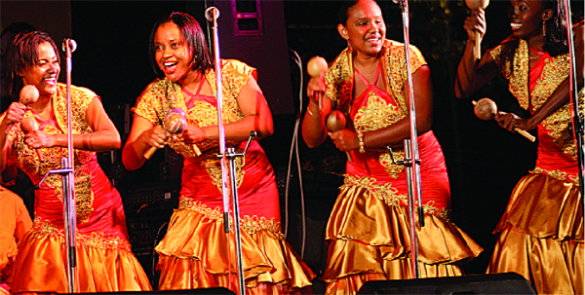This account of parang music, the music of the Trinidad Christmas, was posted by Shaina Lipp in Afropop Worldwide, 9th November, 2012.
Wake up n’ get out of bed! The parranderos are here to serenade us! Living in Trinidad and Tobago in the early 1970s, you may have fallen the not-so-unlucky victim of parang, a semi-seasonal activity in which groups of musicians and revelers pay festive night time visits to houses in small communities. So, break out the food or the rum and let’s dance!
Parang is one fortunate and fruitful example of the cultural transmission (and the subsequent borrowing and fusing of traditional forms) that results from this travel. The word parang is derived from two Spanish words: ‘parranda,’ meaning ‘fête, or spree’ and ‘parar,’ the verb ‘to stop.’ Traditionally, the serenaders of parang (parranderos) visit the homes of families and friends during the night to wake them from sleep; they play music, dance and sing as they go paranging throughout the town to spread good vibes and general merriment. In exchange for entertainment, parranderos are usually given food and drink: pastelle (a type of bready desert), sorrel and rum.
The earliest examples of the music are heavily influenced by joropo, a classic style of Venezuelan folk music, but quickly came to include a significant helping of Caribbean groove in the mix. Because parang takes its original influences from Afro-Venezuelan culture, we see an instrumentation that reflects this migratory origin: the cuatro, maracas, claves, box bass, bandolin, caja and the marimbola. But the parranderos do not stop there! For the best sound, wood blocks and graters, scratchers and spoons are incorporated into the mix, adding a percussive heft to the soaring vocals.
Over the past several decades, parang has changed in some significant ways, accounting for broader developments in Trinidad and Tobago’s cosmopolitan musical culture. While the caroling-type tradition is still practiced in some places during the holidays, larger and more organized ensembles have expanded the style, doing much to professionalize the once informal sub-genre. In the course of doing so, the parang season has been extended significantly . What was once a holiday custom now takes up much of the year, beginning in October and running through January, and culminating in a series of national contests hosted by National Parang Association of Trinidad and Tobago (NPATT). With the addition of new instruments, the implementation of riddims and more English language, parang has aligned more closely with mainstream Trinidadian culture.
Perhaps most exciting are the recent developments…In an unprecedented announcement, the NPATT ruled: regarding all competitions and official instrumentation, parang now officially incorporates the steelpan! While in the past some groups have played steelpan, now for the first time it will be considered as an official component of the parang ensemble and will be judged alongside the more traditional instruments in the competitions that define success for parranderos. It would seem the addition of pan is a smart move on the part of the NPATT, given plethora of new possibilities available to the instrumental expansion, such as soca-parang, and will likely increase versatility of the genre. and we can’t wait to hear it!
For the original post: Bailan los parranderos! • Afropop Worldwide.
